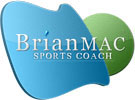

The key is aptitude training
Brian Grasso explains his approach to teaching movement skills to young athletes.
In the initial phases of training with a young athlete (technically referred to as General Preparatory or GPP), the undeniable key and focus (outside of fun) should be aptitude development. This aptitude should transcend to both movement-based skills in their basic elements (balance, jumping, throwing, linear and lateral motion progressions, etc.) as well as strength-based exercises. I have always firmly believed that basic squatting techniques, for example, (squatting variations and unilateral efforts), should be introduced into the training sessions of young athletes.
How does one begin the process of teaching movement habits?
When working with young athletes (6 to 7 years old), one needs to adopt a progression template within which to work. No template can ever be applied to 100% of your athletes 100% of the time - that is the beauty of coaching; understanding what to apply, when, and for how long (i.e., knowing when to progress or regress on an individual basis).
After ten years of working with young athletes, I have reached one undeniable conclusion - the more I learn, the more I realise I do not know, and the more I want to change my methodologies. Let us look at how I progress the teaching of movement skills, e.g., the "lateral deceleration". Firstly, break the key points of the movement into skill sets that are easy to remember so that kids can recite them to you and themselves (this makes teaching and cueing much simpler). I have four points I require my young athletes to learn/know/commit to memory for the "lateral deceleration" movement skill:
- Bend your knees and drop your hips.
- Be on a flat foot or slightly on the ball of the foot.
- The toe/foot of the decelerating leg should be square to the angle of the body (i.e., not out).
- The foot placement should be outside the box (the 'box' is a reference to an invisible line drawn from the shoulder to the floor). Any placement outside of that line is good; within or too close to the line will result in poor deceleration and potential injury.
Once the young athletes understad each of these points individually and in conjunction with each other, I then progress the learning in three phasess: tatically, dynamically, and randomly.
Statically
Have the athletes assume an athletic position or stance. From here, they will 'hit' the decelerating position upon command. Be patient with this step and make sure all your athletes are comfortable and competent with the motion. Add fun to this by calling out different legs unpredictably.
Dynamically
When you feel your athletes are ready, have them perform one or two moderately paced side shuffles before 'hitting' the decelerating position. The side shuffles should be slow and easy. At this point, you will begin to ascertain if further teaching is necessary (it will be). With the additional movement before the deceleration, a common mistake you will see is athletes not planting their foot outside of the box far enough. This results in poor alignment and a less-than-satisfactory deceleration (even at these slow speeds). My colleague, Lee Taft, calls this a shoulder sway (because the shoulders lean towards the decelerating leg rather than sitting back in a 'braking' type position). I love this term, which reflects what the actual concern looks like.
Randomly
Now that the athletes are comfortable with the motion, create games and situations within which they react to a particular signal and move (unpredictably) in different directions. On your 'point', for example, the athlete will take one or two moderately paced side shuffles and then 'hit' a deceleration. Have them hold the position so that both you and they can ascertain what is right and wrong with their posture.
Article Reference
This article first appeared in:
- GRASSO, B. (2006). The key is aptitude training. Brian Mackenzie's Successful Coaching, (ISSN 1745-7513/ 30 /March), p. 6-7
Page Reference
If you quote information from this page in your work, then the reference for this page is:
- GRASSO, B. (2006) The key is aptitude training [WWW] Available from: https://www.brianmac.co.uk/articles/scni30a5.htm [Accessed
About the Author
Brian Grasso is the President of Developing Athletics, which is a company dedicated to educating coaches, parents, and youth sporting officials throughout the world on the concepts of athletic development. Brian can be contacted through his website at www.DevelopingAthletics.com